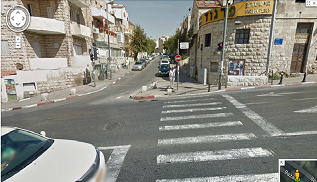 Jerusalem, January 1 – Cutting through the maze of alleys and narrow, one-way streets in the historic neighborhood of Nachlaot is Betzalel Street, where a twice-daily ritual takes place during rush hour as drivers routinely imperil pedestrians by barreling through ill-designed crosswalks. The municipality plans to add at least three more such intersections to the city’s streets in 2014, a mayoral spokesman announced this morning.
Jerusalem, January 1 – Cutting through the maze of alleys and narrow, one-way streets in the historic neighborhood of Nachlaot is Betzalel Street, where a twice-daily ritual takes place during rush hour as drivers routinely imperil pedestrians by barreling through ill-designed crosswalks. The municipality plans to add at least three more such intersections to the city’s streets in 2014, a mayoral spokesman announced this morning.
As traffic volume exceeds the capacity of Betzalel, cars backed up bumper-to-bumper inch up the road toward the even more congested center of town, and the ambiguous nature of one intersection invites drivers not to notice the red light that would allow pedestrians to cross the street. When they nevertheless assert their prerogative to do so, angry drivers blame their own ignorance, real or feigned, that the big red light up ahead means they must stop.
At the root of the phenomenon, says city engineer Ron Demmover, is the bizarre layout of the intersection. Traffic from Nissim Bacher may only turn right, down Betzalel. Accordingly, instead of being required to stop before Betzalel actually meets Nissim Bachar, drivers heading uphill on Betzalel must stop at the crosswalk just beyond the intersection. Nissim Bachar does not continue across Betzalel, giving the uphill drivers no indication on their right side that they have entered an intersection.
To increase the risk to pedestrians, the city planted a tree right in front of one of the two traffic signals governing the intersection, the one that stands right at the crosswalk. Thus the only signal clearly visible to drivers headed up the street is a traffic light set back about fifteen meters beyond the intersection. “It’s a crazy sight,” says Demmover. “You get cars moving right through the crosswalk on a red light, then stopping four car lengths later, in the middle of nowhere, because, hey, look, a red light.”
To showcase its commitment to endangering pedestrians, the administration of Mayor Nir Barkat issued a press release today in which it expressed its commitment to spreading the design flaws of the Betzalel/Bachar intersection to other parts of the city. “The malicious engineering produced by our elite team of misanthrope bureaucrats will give rise in 2014 to deadly junctions in the neighborhoods of Givat Shaul, Kiryat Moshe, and Kiryat HaYovel,” read the statement, referring to neighborhoods along the western edge of the city. The release also said the city has not capped the number at three, and is open to redesigning intersections in the more central areas of Baka and Talpiot to help bring the specter of being maimed by a ton or so of moving steel to more and more Jerusalem residents.
Not everyone is pleased with the move. Ateret Shulman, whose four-year-old daughter was hit by a car at the intersection in question, laments the investment, noting that her child was hit by a car heading downhill, where the obscured and badly placed signals were irrelevant; the driver had simply ignored a red light. “There’s no need to rearrange entire junctions,” she argues. “Just install traffic lights that aren’t as easy to see, and forget it.” A mayoral spokesman explained that such a move would also risk accidents between vehicles, when the target audience, so to speak, is people on foot.
The measure focuses exclusively on the western section of the city, which houses mostly Jews. The eastern portion, captured by Israel from Jordan in 1967 and annexed, contains mostly Arab non-Jews who, like most of the rest of the world, do not recognize Israel’s claims to that part of Jerusalem. Successive mayoral administrations have had to contend with accusations that they neglect to provide adequate municipal services to Arab neighborhoods in East Jerusalem. In an odd political twist, this initiative, though it focuses only on West Jerusalem, would result in bringing the two sections of the city closer to equality: the municipality has invested little in improving the infrastructure of the Arab neighborhoods, including the maintenance of crosswalks, making every pedestrian venture onto asphalt there a game of Frogger. Now the residents of the western part would find more exposure to the experience.

